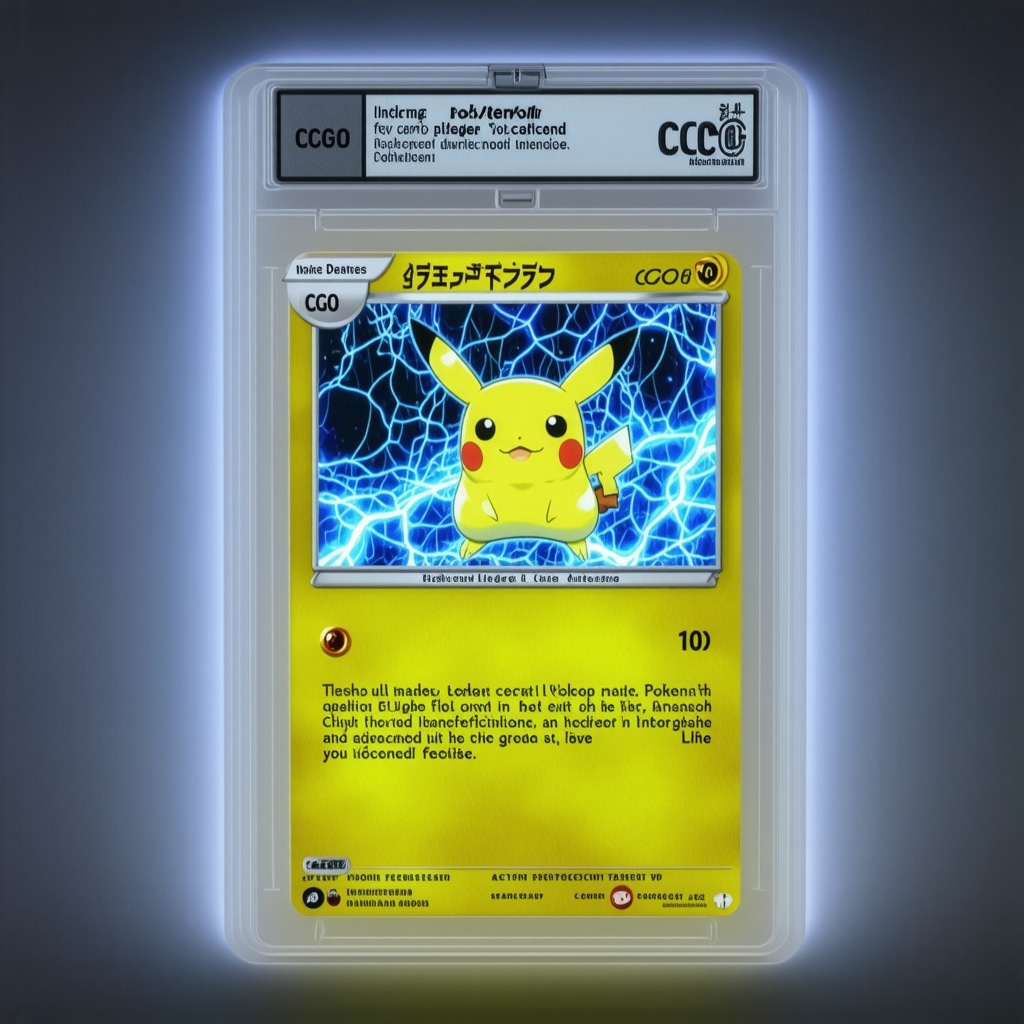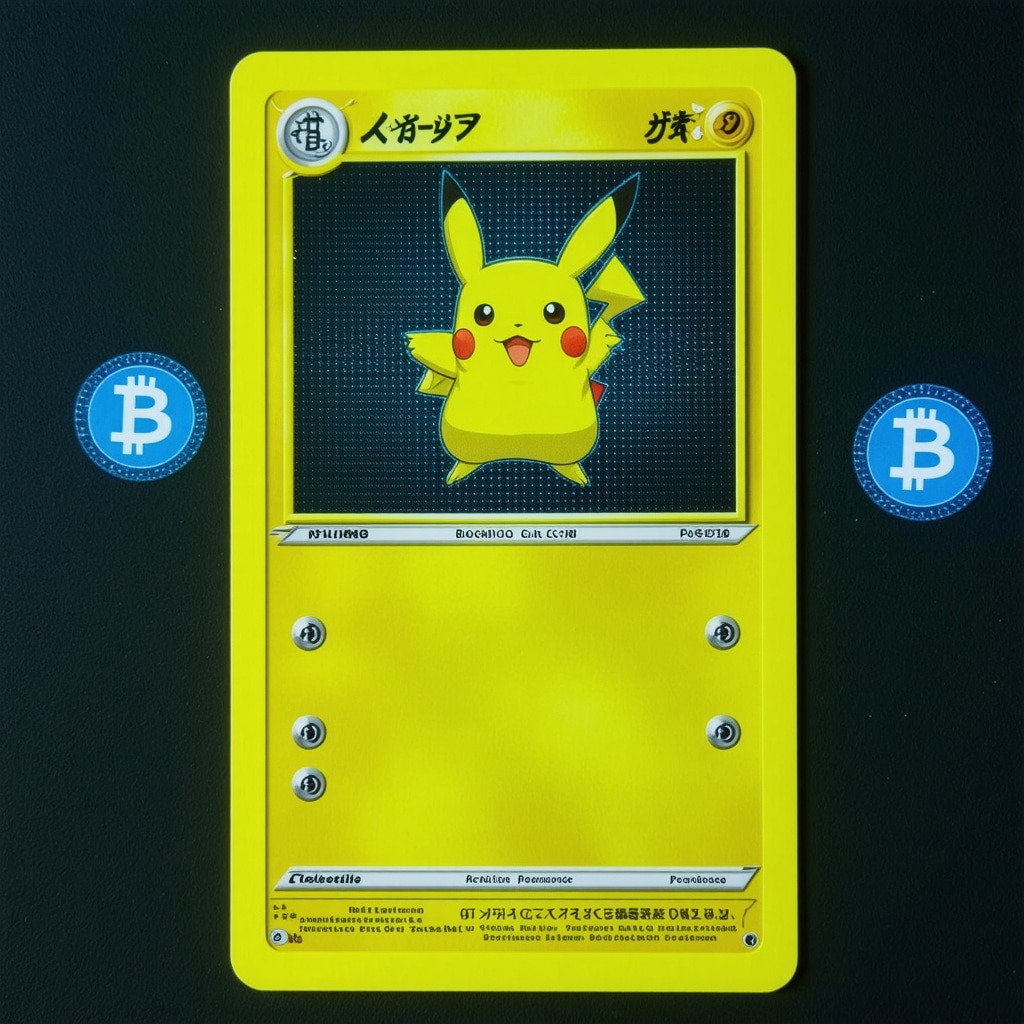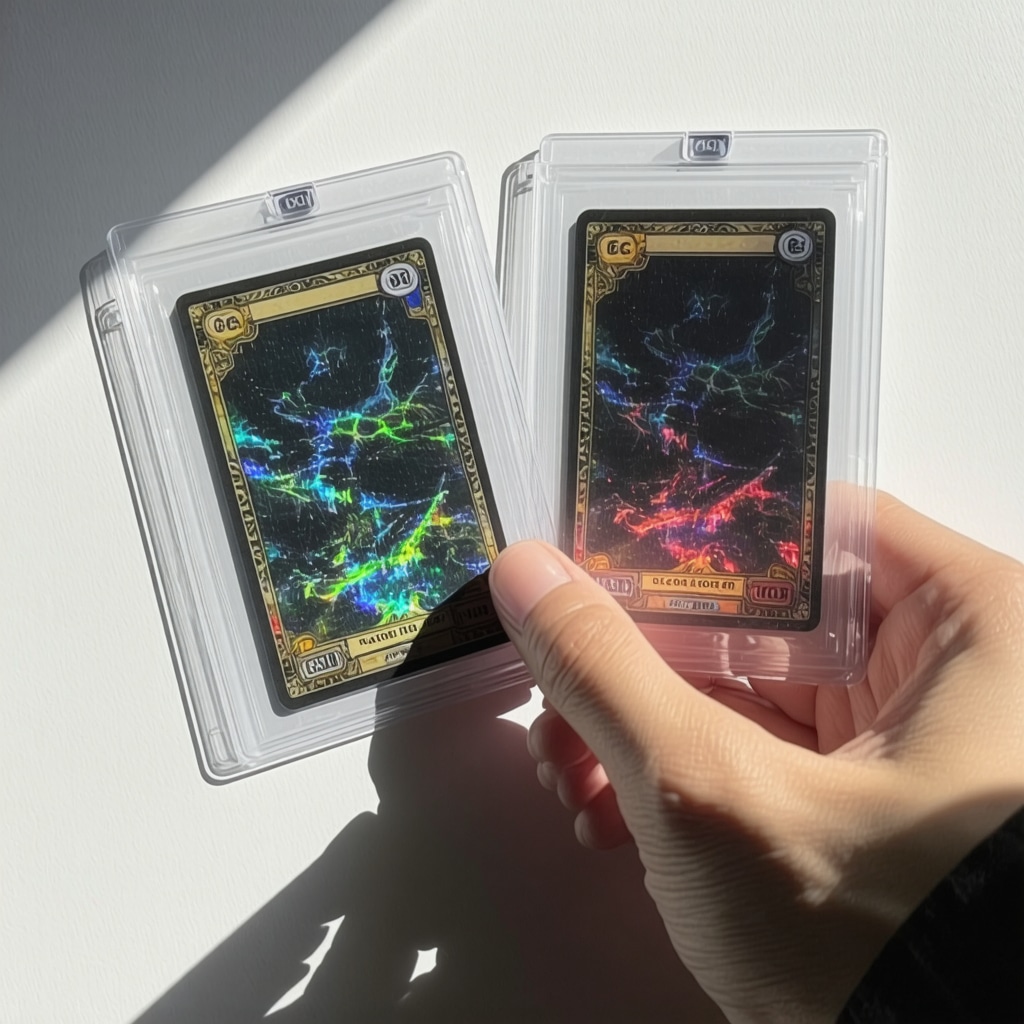When the Magic of CGC 10 Meets the Menace of Fakes
Picture this: you’re at a bustling card convention, the air thick with excitement and the faint scent of nostalgia. You spot a gleaming CGC 10 graded Japanese promo card—perhaps a rare Pikachu or a dazzling Charizard—sparkling under the lights. Your heart skips a beat. But wait, could this gem be a cleverly disguised counterfeit? The market for CGC 10 Japanese promo and special edition cards is booming, and with soaring prices, the fakes are coming out in force. So, how do you dodge the deceivers and secure the real deal?
Decoding the Details: The Devil’s in the Grading
First off, understanding the CGC grading system is your secret weapon. CGC’s Gem Mint 10 grade is no joke—these cards are flawless and pristine. But scammers are getting crafty, replicating labels and slabs that look suspiciously authentic. A quick tip? Check the label font and holographic sticker closely. Authentic CGC slabs have a distinct hologram that’s tough to replicate. For an expert breakdown on grading standards, you might want to explore this detailed guide that dives deep into Japanese Pokémon card grading nuances.
Subtle Signs That Shout “Fake!”
Look beyond the slab. Flip the card and scrutinize the surface texture and color saturation. Japanese promos have unique print qualities—colors should pop vibrantly but subtly, not look flat or overly glossy. The card edges? Crisp and clean, not fuzzy or uneven. Even the font on the card itself is a giveaway—mismatched characters or blurry text is a red flag. Remember, counterfeiters often miss these minuscule details that seasoned collectors can spot in a heartbeat.
Is Your Gut the Ultimate Detector?
Ever had that nagging feeling that something’s off about a card? Intuition is a collector’s underrated ally. If a deal sounds too good to be true, or the provenance is murky, don’t ignore that inner alarm. Authentic CGC 10 Japanese promo cards rarely come cheap and always come with clear certification trails. When in doubt, reach out to trusted experts or contact the grading company directly to verify serial numbers.
Why Not Trust Your Trusted Sources?
Speaking of experts, the community around CGC 10 Japanese cards is robust and knowledgeable. Sites like Pristine Pokemon Cards offer invaluable tips and up-to-date market insights that can help you identify fakes swiftly. Plus, keeping an eye on market trends via reputable auction sites and forums can save you from costly mistakes.
According to a report from The Official Pokémon Company, authenticity checks are becoming increasingly critical as the collectible market expands globally. This means staying vigilant and informed isn’t just savvy—it’s essential.
So, dear reader, what’s your foolproof method for sniffing out a counterfeit? Share your stories and tips in the comments below—let’s build a community that keeps the joy of collecting alive and the fakes at bay!
Inside the Mind of a Counterfeiter: What Makes CGC 10 Japanese Cards Hard to Fake?
It’s tempting to think that a CGC 10 slabbed card is foolproof proof of authenticity, yet counterfeiters are evolving rapidly. One of their strategies involves mimicking the microprinting details and holographic seals on CGC slabs, a highly technical challenge that requires sophisticated equipment. However, even the most convincing forgeries struggle to replicate the subtle nuances of ink layering and card stock texture unique to Japanese promos. Understanding these microscopic characteristics can be your ace in the hole. For a thorough dive into these grading intricacies, consider reviewing this expert guide, which lays out the nuanced grading standards that separate true CGC Gem Mint 10 cards from near-perfect fakes.
How Do Market Dynamics Influence Authenticity Risks?
The surge in demand for CGC 10 Japanese promo and special edition cards has created a lucrative playground for counterfeiters. Prices for rare cards like the Japanese Charizard or limited edition Pikachu have skyrocketed, attracting not only collectors but also opportunists aiming to exploit the craze. Market liquidity and hype cycles can inflate risk, making it essential for investors and hobbyists alike to remain vigilant. Monitoring trustworthy marketplaces and auction platforms reduces exposure to fraud. For example, eBay has become a double-edged sword where legitimate sellers and counterfeit listings coexist—knowing how to differentiate between the two is crucial.
Could Advanced Technology Be the Future of Authentication?
With the rise of blockchain and AI technologies, one wonders: could these innovations revolutionize how we verify the authenticity of CGC 10 Japanese promo cards? Imagine embedding digital certificates directly linked to the physical card’s serial number or using AI-driven image analysis to detect the tiniest inconsistencies in card printing. These technologies promise to add layers of security and transparency, but adoption is still in early stages. Meanwhile, collectors must rely on time-tested methods and expert verification.
Building a Trusted Network: Why Community Matters
One of the most effective defenses against counterfeit CGC 10 Japanese promo cards is leveraging the collective wisdom of the Pokémon card community. Forums, social media groups, and specialized websites provide platforms for sharing experiences, spotting fakes, and exchanging advice. Engaging with these communities not only sharpens your detection skills but also keeps you abreast of emerging counterfeit techniques and market trends. A proactive approach includes connecting with reputable dealers and graders, as outlined in Pristine Pokemon Cards’ contact resources.
According to Collectors Weekly, experienced collectors emphasize the importance of provenance and purchase history in authenticating collectibles—advice that applies strongly to CGC graded Pokémon cards.
Have you ever encountered a suspicious CGC 10 Japanese promo card? Share your story or tips in the comments below to contribute to a safer, more informed collecting community. Your insights could save someone else from a costly mistake and enrich our collective expertise.
Leveraging Forensic Analysis: Microscopic Scrutiny in Card Authentication
When the surface-level inspection leaves doubts, advanced collectors turn to forensic analysis techniques that delve deep beneath the card’s visible features. Tools like high-powered microscopes and spectral imaging reveal ink deposition patterns and print layering unique to authentic Japanese promos, which counterfeiters rarely replicate accurately. For instance, ultraviolet (UV) light inspection can expose inconsistencies in ink fluorescence—a hallmark of forged prints. These forensic methods require specialized equipment but offer a nearly foolproof layer of verification for high-stakes transactions.
How Can Spectral Imaging Differentiate Authentic Japanese Promo Cards from High-Quality Fakes?
Spectral imaging captures light absorption and reflection signatures of card materials, revealing subtle discrepancies invisible to the naked eye. Authentic CGC 10 Japanese promos exhibit distinct spectral fingerprints due to their specific printing inks and card stock sourced exclusively from Japanese manufacturers. In contrast, counterfeit cards—even those mimicking surface textures—display divergent spectral profiles because counterfeiters use different inks and substrates. Engaging with laboratories or expert graders who employ spectral imaging can drastically reduce the risk of acquiring fakes.
Research published in the Journal of Forensic Sciences highlights the efficacy of spectral methods in discriminating counterfeit collectibles, underscoring their growing relevance in the Pokémon card market.
Integrating Blockchain for Tamper-Proof Provenance Tracking
Blockchain technology is emerging as a transformative solution to the authenticity conundrum. By registering CGC 10 Japanese promo cards on a decentralized ledger, each card gains a unique, immutable digital identity linked to its physical counterpart. This system enables transparent provenance tracking, preventing tampering or fraudulent certification. Some pioneering platforms are already collaborating with grading companies to embed QR codes or NFC chips on card slabs, which, when scanned, verify the card’s history and grading details secured on blockchain networks.
While adoption remains limited, industry insiders predict widespread integration within the next five years, promising to elevate collector confidence and market integrity significantly.
Psychology of the Collector: Navigating Cognitive Biases in Authentication Decisions
Even the most seasoned collectors are susceptible to cognitive biases that can cloud judgment. The allure of owning a rare CGC 10 Japanese promo card may induce confirmation bias, where one overlooks red flags to affirm belief in authenticity. Similarly, social proof from peer endorsements or inflated market hype can lead to overconfidence and impulsive purchases.
Mitigating these biases requires deliberate strategies: maintaining objective checklists, seeking second opinions, and periodically reframing the acquisition process as an analytical endeavor rather than an emotional pursuit. Cultivating such mental discipline complements technical verification methods, forming a holistic defense against counterfeit risks.
Collaborative Authentication: Building Expert Alliances for Enhanced Verification
Pooling expertise through collaborative networks enhances authentication accuracy. Platforms facilitating peer reviews of high-value cards, where collectors and graders share high-resolution scans and forensic data, empower the community to collectively flag suspicious items. These alliances often involve cross-referencing serial numbers with multiple grading databases and sharing insights on emerging counterfeit techniques.
For collectors eager to deepen their expertise, joining specialized forums such as the Pokémon Trading Card Game Forum or attending industry conferences can be invaluable. These engagements not only sharpen detection skills but also foster relationships with trusted dealers and authentication experts.
Ready to elevate your collecting acumen? Dive deeper into forensic authentication techniques and join expert communities to safeguard your CGC 10 Japanese promo card investments. Your journey towards mastery starts with informed vigilance and collaborative learning.

Beyond the Surface: Leveraging Multispectral Analysis to Detect Sophisticated Forgeries
In the evolving landscape of Pokémon card collecting, counterfeiters have refined their craft to a near art form, especially targeting coveted CGC 10 Japanese promo cards. To stay ahead, collectors and experts are turning to multispectral imaging—a technology that captures images of cards under various wavelengths beyond visible light, such as infrared and ultraviolet. This technique uncovers hidden layers of ink composition and printing anomalies invisible to standard inspection, offering a powerful line of defense against even the most convincing forgeries.
Multispectral analysis can reveal discrepancies in ink pigments and layering, identifying counterfeit cards that superficially mimic authentic print textures and colors. For those serious about protecting high-value collections, understanding and accessing these technologies is becoming increasingly vital. This approach complements traditional grading insight found in CGC grading standards, providing a forensic edge that helps differentiate genuine CGC Gem Mint 10 cards from expertly fabricated replicas.
The Role of Provenance Digitization: How Digital Ledgers Enhance Trust in the Card Market
Digital provenance tracking—anchored by blockchain technology—is reshaping how collectors authenticate and trade CGC 10 Japanese promo cards. By assigning each card a unique digital identity immutable on decentralized ledgers, provenance digitization secures transaction history and grading authenticity against tampering. Collectors can scan embedded QR codes or NFC chips on slabs to instantly verify a card’s certification and ownership lineage in real time.
Platforms integrating these systems aim to combat counterfeit infiltration effectively by ensuring that every high-value CGC 10 Japanese card carries a tamper-proof record. Early adopters in the collectibles space, as referenced in the Forbes Technology Council, highlight blockchain’s potential to revolutionize market transparency and trust, creating a safer environment for both hobbyists and investors.
How Can Expert-Led Peer Review Networks Improve Authentication Accuracy?
Traditional grading agencies and forensic methods are critical, yet the human element remains indispensable. Expert-led peer review networks—where seasoned collectors, graders, and forensic analysts collaborate—have emerged as an advanced authentication layer. These networks facilitate sharing of high-resolution scans, forensic data, and provenance details to cross-validate card authenticity.
By pooling collective expertise, such communities can identify subtle inconsistencies or newly emerging counterfeit techniques faster than isolated individuals or even grading companies alone. Joining specialized forums like the Pristine Pokemon Cards contact resources or the Pokémon Trading Card Game Forum offers access to these collaborative hubs, empowering collectors to make more informed decisions.
Understanding the intricate balance between technology, community, and psychology is crucial. Experienced collectors also warn against cognitive biases such as confirmation bias, which can distort judgment when investing in high-stakes CGC 10 Japanese promo cards. Objective verification checklists and peer consultation can mitigate these risks effectively.
Are you leveraging advanced authentication tools or community networks in your collecting journey? Share your experiences or questions below and join a growing collective dedicated to preserving the integrity and passion of Pokémon card collecting.

Expert Insights & Advanced Considerations
The Subtle Art of Ink Layer and Substrate Analysis
Beyond surface inspection, understanding the microscopic ink layering and card stock unique to Japanese promos is critical. Authentic CGC 10 cards possess distinct ink deposition patterns that counterfeiters struggle to replicate. Employing forensic tools like spectral imaging provides a powerful edge in distinguishing genuine cards from high-quality fakes.
Leveraging Blockchain for Immutable Provenance
Integrating blockchain technology offers a transformative way to secure card authenticity and provenance. By linking physical cards to tamper-proof digital identities, collectors can verify grading and ownership history instantly, drastically reducing fraud risk. Although still emerging, this approach is poised to redefine market transparency.
Community-Driven Authentication Networks
Pooling expertise through expert-led peer review forums enhances accuracy in authentication beyond traditional grading. These networks facilitate sharing detailed scans, forensic data, and provenance verification, enabling swift identification of counterfeit trends and fostering collective vigilance.
Mitigating Cognitive Biases in High-Stakes Collecting
Collectors must remain vigilant against psychological biases such as confirmation bias and social proof, which can cloud judgment when acquiring CGC 10 Japanese promo cards. Employing objective checklists and seeking external expert opinions ensures decisions remain grounded in evidence, protecting investments.
Market Dynamics and Authentication Risks
Rising demand and soaring prices for rare CGC 10 Japanese cards attract sophisticated counterfeiters. Understanding market liquidity, hype cycles, and the nuances of reputable platforms enables collectors to navigate risks effectively and avoid costly pitfalls.
Curated Expert Resources
- Pristine Pokemon Cards – Offers an authoritative deep dive into CGC grading standards, forensic authentication techniques, and market insights tailored for Japanese Pokémon cards collectors.
- Pokémon Trading Card Game Forum – A vibrant community hub where expert collectors and graders collaborate to share authentication strategies and peer review high-value CGC 10 cards.
- Journal of Forensic Sciences – Publishes critical research on spectral imaging and ink analysis relevant to counterfeit detection, providing scientific grounding to authentication methods.
- Forbes Technology Council – Features expert commentary on blockchain applications for collectibles, illustrating how technology enhances provenance security.
- Collectors Weekly – Provides valuable perspectives on provenance importance and practical advice on avoiding counterfeit collectibles, applicable to CGC graded Pokémon cards.
Final Expert Perspective
Authenticating CGC 10 Japanese promo Pokémon cards demands an intersection of advanced forensic techniques, innovative technology, and collaborative community intelligence. Mastery arises not just from spotting visible flaws but from understanding ink science, provenance digitization, and psychological discipline. As counterfeiters sharpen their craft, so too must collectors refine their expertise through continuous learning and trusted networks.
Elevate your collecting journey by exploring resources like detailed grading guides and engaging with expert communities. Share your insights or questions to contribute to a resilient, informed collector ecosystem that preserves the true joy and value of CGC 10 Japanese promo cards.
